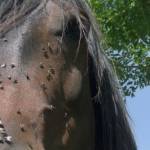Fly Control for Horse Barns

Flies are a fact of life around horse barns and other livestock facilities, or are they? According to a study conducted at the University of Florida, fly populations increase and decrease in relation to some factors that humans can’t control, such as air temperature and other weather patterns. Stable management practices, however, can have an impact on reducing fly populations.
How manure is handled is of major importance. The farm that had the fewest flies removed each day’s manure and stall waste to a separate pile. Within a few days, that pile was mixed into a “working” compost row that was regularly turned, speeding bacterial fermentation and generating enough heat to kill fly larvae. Simply piling manure won’t work very well, but turning and aerating the compost is very effective in disrupting the reproductive cycle of flies. This farm reported no insecticide use, a testament to the efficacy of their management plan.
Two farms in the study chose to spread manure and soiled bedding on fields, an acceptable management practice that can decrease fly populations if it is done correctly. One farm spread the manure thinly over a wide area, allowing the material to break down with exposure to sunlight. At the other farm, waste was spread on the same path day after day, eventually building up a thick layer of wet organic matter that was an ideal breeding ground for flies. This farm had the highest fly population of any in the study.








